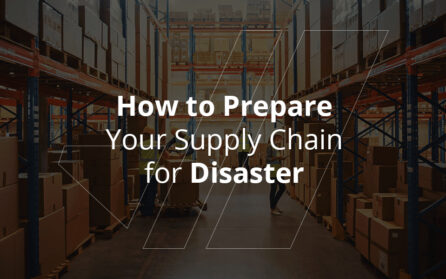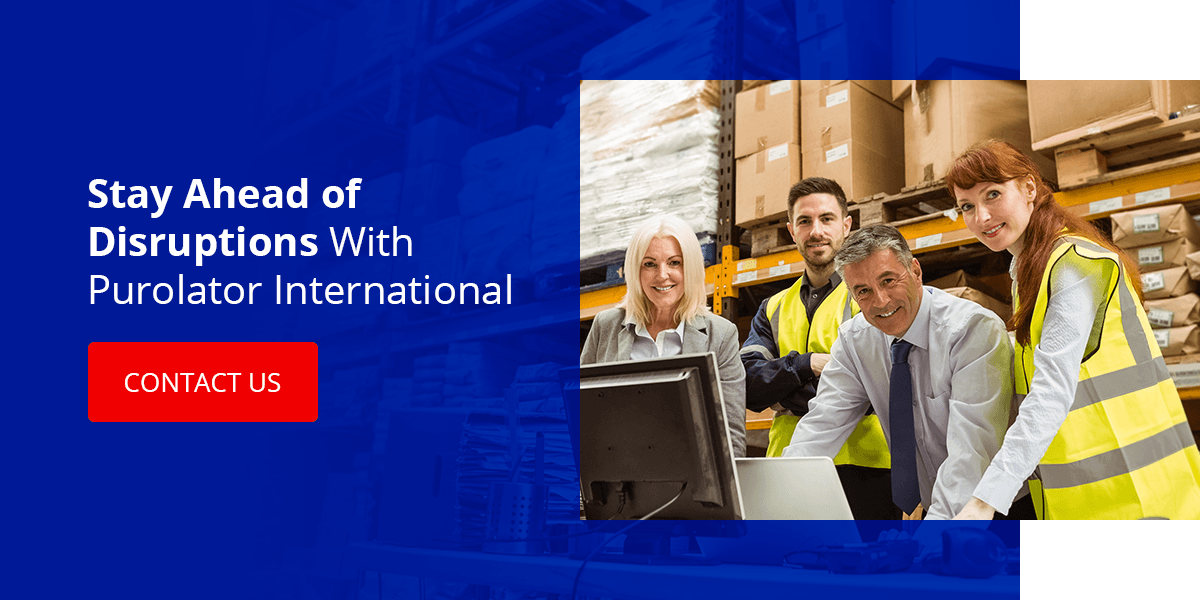Blog
How to Prepare Your Supply Chain for Disaster

Within your supply chain, an extensive network of people and organizations work to move products from suppliers to consumers. These processes are tightly interconnected, meaning any disruption can create detrimental impacts that affect the rest of the chain.
Whether you’re facing local or global economic issues, industry and market challenges or natural disasters, it’s important to start with strengthening your supply chain and practice resilience. Over time, your business will improve supply chain disaster management, effectively maintain operations and keep your chain productive.
Keep reading to learn how to create a supply chain that survives disaster.
- How to Create Robust Supply Chains
- Disasters Affecting Supply Chains
- Supply Chain Disaster Management
- Stay Ahead of Disruptions With Purolator International
How to Create Robust Supply Chains
Supply chain challenges are particularly difficult to manage because they affect many sectors of the industry. Tackling one obstacle often means fixing other issues along with it. As a distributor or shipping company, here are some top steps you can take to diversify your supply chain and ensure it’s constructed to reduce costs and the risk of disruption:
- Diversify your supply chain: Maintaining solid relationships with several reliable suppliers can help create healthy competition for better prices and services. Supply chain diversification can also improve the odds of success.
- Value communication: Without communication, your suppliers won’t know what you need from them. Discuss clear needs, goals and response expectations to reach your desired outcomes.
- Create strong relationships: Build reliable, mutually beneficial foundations between your organization, suppliers, management team and stakeholders.
- Have a backup plan: Having a contingency plan in place can help mitigate inevitable catastrophes and supply chain interruptions and ensure you continue to meet consumer needs.
- Develop forecasts and keep track of data: Ensure your data is accurate to help you improve operations, avoid revenue losses and work with suppliers to determine industry forecasts for potential demand. This strategy can help you prevent under-delivering and overstocking.
Disasters Affecting Supply Chains
From devastating local communities to complete global disruption, it’s essential to know how your business can become affected by disasters and how to minimize such impacts. Here are some common natural, economic and industrial disasters that have occurred in recent years that may have affected your business logistics and operations.
1. Natural Disasters
Aside from economic and industry issues, natural disasters can significantly impact eCommerce and individual supply chain sectors. Natural disasters can occur at any time and affect millions of livelihoods at once. Some common natural disasters that can affect the global economy include:
- Hurricanes
- Tornados
- Tsunami
- Blizzards
- Earthquakes
- Thunderstorms
- Flooding
- Wildfires
Natural disasters create a ripple effect through the supply chain. Businesses in the affected area might not be able to obtain supplies or shipments they need on time, which also affects the consumer.
These disasters can block highways and airports, causing transportation delays and failures for local and international shipping. This issue can lead to increased strain on transport networks and trade routes, slowing the movement of vital products. It can create canceled cargo flights and deliveries or force you to stop processes until all businesses in your chain can operate normally.
Natural disasters often highlight areas of the supply chain you need to improve for balanced supply and demand, so it’s critical to mitigate these issues and find alternative ways to keep your supply chain operational during emergencies.
2. Pandemics
The COVID-19 pandemic has created widespread and significant disruptions within the supply chain, affecting inventory, sales, manufacturing and trade. In the first few months of the pandemic, many businesses struggled to hire employees and keep enough products in stock.
Because of the COVID-19 impact, it’s essential to create a pandemic-proof supply chain to help stabilize your shipments and meet demand during such a crisis.
3. Cyberattacks
Like natural disasters, cyberattacks can occur at any time and have detrimental effects on businesses that haven’t properly protected themselves. If any link in your supply chain lacks adequate security protocols, it’s easier for hackers to access your data and disrupt your entire operation.
Cyberattacks are expensive and complex to fix, costing the global economy about $445 billion annually. It’s critical to maintain robust security processes and maintain strong communication within your chain to help identify any vulnerabilities.
Supply Chain Disaster Management
A significant part of managing disasters is strengthening your logistics plan and preparing for every type of disaster. Preparing your business for unexpected delays, shortages, inflation and other types of threats can help you stay competitive and keep operations running. Be sure to consider the after-effects of the markets and the direct impacts on your infrastructure.
1. Create an Emergency Plan
You should always have a disaster plan in place that outlines different ways to move supplies and goods around in case of emergencies or natural disasters. Think about all possible disasters that commonly occur in your local area and how a global catastrophe could affect areas of your supply chain.
You can also set aside an emergency fund and work with your partners to align risk management processes and help ease the disruption. Consider these situations as opportunities to improve and identify what you and your team did right to remain prepared.
2. Analyze and Monitor for Threats
Another way to prevent supply chain issues is to monitor potential economic, natural or political threats that can have disruptive impacts.
It’s a good idea to keep track of weather alerts, run a data analysis and conduct a supply chain vulnerability audit to help identify the weakest links and find alternative methods. You should also monitor any conditions or events that may impact your trade routes.
3. Understand Risks and Be Flexible
It’s important to remain open with your team and partner companies about any events or natural disasters that might affect areas of your supply chain. Adopt risk evaluation tools and technology to help evaluate threats like cyberattacks, shortages or any other potential problems.
Another best practice is to understand how certain risks will affect your organization’s operations and reputation. Make sure you plan properly so your partners and consumers will know you’re a responsible, dependable company. You can engage with your suppliers and communicate that you’re open to more flexible methods in the event of a disaster.
4. Build Backup Inventory and Suppliers
Develop a stock of essential supplies that would help keep your business running for a few months during a disaster. If a high-category hurricane were to hit your local area, your supply chains might be temporarily cut off, so it’s a good idea to have a store of goods and materials.
In addition to inventory, you should also keep your communication lines open for backup suppliers. If your supplier in a different country isn’t able to deliver your goods to you, you can rely on a supplier in a different location to step in when you need them.
5. Partner With a Shipping Service Company
Implementing a company that can find the right carriers and routes for cross-border transit can be particularly helpful during natural disasters. While domestic supply chain issues can be challenging to overcome, cross-border shipments can create expensive, time-consuming shortages and delivery delays.
With the help of a shipping specialist, your business can benefit from consolidation services, an extensive network and reach the U.S. and Canada both in the air and on the ground. Partnering with a logistics company that can improve your bottom line and has expertise in your industry can make it easier for you to adjust your supply chain processes and save you money in the long run.
Stay Ahead of Disruptions With Purolator International
Dealing with unexpected interruptions and natural disasters can affect your organization’s resiliency and efficiency. It’s critical to regularly reassess your emergency response plans and determine which suppliers and partners can help you stay productive during these times.
At Purolator International, we deliver unsurpassed automated shipping solutions, extensive distribution networks and warehousing and inventory management. We have a wide range of supply chain services designed to meet your specific needs and facilitate your most important shipments.
Contact us today to see how our services and resources can help keep your supply chain secure.

